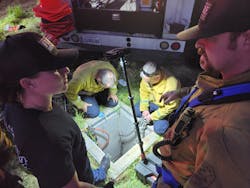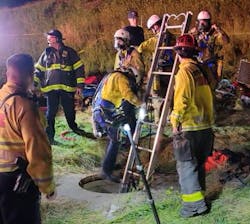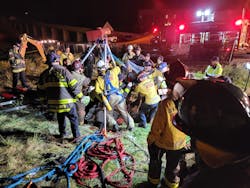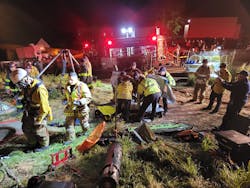At 5:38 p.m. on March 20, 2022, the Contra Costa, CA, Regional Fire Communications Center (CCRFCC) received a call for service in Antioch, CA. The reporting party reported hearing moaning and believed that someone was inside of a drainage pipe. CCRFCC dispatchers are expert in extracting information and determining the best response, and a confined-space rescue response was initiated.
The location of the incident was in a challenging area, with inconsistent sloping, heavy grass and various types of debris. It was bordered by a strip mall, sewer and water pipelines and a street.
The Antioch Police Department arrived first and advised CCRFCC that they attempted to contact the victim by calling into a stone drainpipe but heard nothing.
This was communicated to the first-due battalion chief, Battalion 8, and he advised all responding units and CCRFCC to continue the rescue response until a Contra Costa Fire Protection District (Con Fire) unit was on scene and provided an initial condition report.
Battalion 8 arrived and assumed incident command. The instruction to stage in the parking lot of a nearby grocery store were communicated to all responding fire companies. The incident commander (IC) met with the Antioch police officers to obtain an update and assigned Engine 81, which arrived seconds before Battalion 8, to perform reconnaissance on the pipeline.
The IC performed a 360-degree evaluation of the incident while Engine 81 attempted to contact the victim. The IC then met with Engine 81, and together they were able to make out a faint voice from inside of the pipe. The IC radioed CCRFCC that someone was in the pipe and requested a tactical radio channel. All responding units were directed to switch to the tactical channel for all radio traffic.
Because of the nature of this type of response, the amount of people and equipment that was needed and the length of time that could be required, the dispatchers initiated on-duty crews to move up to cover some of the stations that were responding to the call.
Forty firefighters responded to the incident on three engines, two trucks, two heavy rescues and one breathing support unit. Two battalion chiefs, one safety captain, one fire investigator, two paramedic ambulances, one paramedic supervisor and one public information officer also responded.
A request for assistance from the city of Antioch was made and received. A three-person dig crew that had a backhoe, a sewer technician, a lift truck with a Davit crane and Antioch police officers were added to the call.
Standard practice for Con Fire on any call where an IC is established is to utilize the incident command structure to manage the incident and to give and track assignments. Tablet Command is used to track resources and to assist with necessary assignments per district standard operating procedures and guidelines.Initial size-up/assignments
The initial size-up confirmed that this was, in fact, a confined-space rescue. The IC assigned the captain paramedic of Engine 81 as the medical group supervisor. That member’s crew, the responding paramedic ambulances and the paramedic supervisor were assigned to the medical group.
The captain paramedic of Truck 84 was assigned as the rescue group supervisor, and the crews from his truck, Truck 84, Rescue 10 and Rescue 82 were assigned to him.
The captain paramedic from Engine 85 was assigned as the confined-space rescue safety officer.
The engineer on Engine 85 was assigned to air monitoring, and the firefighter on Engine 85 was assigned to assist him.
The captain paramedic on Engine 88 was assigned as the decontamination unit leader, and his crew set up and maintained the decontamination area.
The shift fire investigator is Con Fire’s drone pilot on duty, and he was assigned to provide aerial reconnaissance.
The breathing support unit was assigned to set up a rehabilitation area and to provide breathing air and logistical support.Actions/considerations/plans
The IC met with each group to formulate a plan to extricate the victim. It was determined that Plans A, B and C were needed, and assignments were determined. Each plan would be executed simultaneously. Based on progress and need, each plan would be modified, adjusted or terminated, if necessary, because one of the important elements of these types of rescues are flexibility and communication: All personnel must be prepared to adjust and pivot, if needed, based on evolving incident priorities and needs.
The area of the incident was sloped at approximately 20 degrees, and the higher area had a sewer grate that led to a vault that gave access to the sewer pipe. As the pipe sloped down the grade, it narrowed and ended at an opening that was approximately 18 inches in diameter. The distance from the vault to the end of the pipe was about 150 feet.
Plan A was to enter the pipe at the 18-inch diameter end to gain access to the victim and to extricate him back through to the point of entry.
Plan B was to enter the pipe through the grate, make access to the vault, and remove a large aluminum plate that was placed between the vault and the pipe to constrict water flow.
Plan C was to excavate the dirt that was around the buried pipe just to the rear of the victim, breach the concrete pipe and remove the victim at his current location.
All of these plans had probabilities of success and could accomplish the desired result of safe victim removal.Once agreement on the plans was reached, each one was executed, and their effectiveness and progress was reassessed regularly. Each plan had its unique challenges, and each team worked diligently to overcome them. Plan A required entry into a very narrow pipe and was complicated by the pipe’s size and distance. Plan B required the most technical applications and needed heavy lifting and shoring elements. Plan C was labor-intensive and required heavy equipment to execute.
Each plan had a leader and a separate crew working on it. Plan A required only a single rescuer in a harness on supplied air and a tether. Plan B required the use of Con Fire’s FirstLook360 camera, a HydraFusion strut with a long shore strut and extension, and heavy lifting chain. Plan C initially utilized crews and shovels to remove the dirt around the pipe, who soon were replaced with the backhoe loader that was provided by the city of Antioch.
As each plan evolved, Plan B emerged as the most conducive to priorities and strategy. Crews began to succeed in lifting the heavy aluminum plate (and, ultimately, securing it) and making a safe way for the entrants. Efforts were adjusted to solely support that plan.
During the lifting phase, the rescue group had assembled an Arizona Vortex tripod with a Haul-Safe 4:1 system and a safety belay line for access and egress to the vault.
Verbal contact with the victim was able to be maintained, and it was determined that he wasn’t in imminent danger throughout the incident.
Entrants accessed the vault via ladders, and debris removal from the pipe began. Once a clear, debris-free path was established and physical contact with the victim was made, the rescue tempo picked up, wristlets were attached to the victim, and he was brought into the vault and packaged in a harness for lifting to the surface.
When the victim was safely out of the vault, the medical group took over and assessed the victim, who now became a patient. He was loaded onto a gurney and into a waiting ambulance for transport to the hospital.
As of press time, the patient’s prognosis was good, and no adverse outcomes from the entrapment or rescue were expected.
The length of time from first rescuer entry into the vault to victim removal to the surface was 53 minutes.
As soon as the patient was removed from the area, crews were instructed to take staggered breaks and go to the rehab area for feeding and recovery.
As crews went through their rehab process, all used equipment was cataloged, cleaned and replaced on the apparatus/prepared for the next response.
All Occupational Safety and Health Administration and fire district laws, regulations and policies were followed throughout the course of the rescue.
Lessons learned
Incidents such as this are resource- and personnel-dependent and require large numbers of people and equipment.
Relationships with agencies outside of the fire, law enforcement and EMS fields must be established and included in training prior to the real incident.
Keeping the area around the ingress and egress clear of nonrescue personnel must occur.
A strong commitment from the entire fire agency can’t be overstated. A total commitment to incidents such as this is essential to prevent any issues that can have catastrophic and deadly outcomes.
Consideration must be given to the decontamination process that’s used and the viability of reusing or replacing contaminated equipment. Tools and equipment should be decontaminated or disposed of according to local and agency protocol.
Training paid off
Through the dedication of the men and women of the Con Fire Technical Rescue Program, on March 20, 2022, all of the members’ years of training, preparation and professionalism paid off: A resident was rescued from a very dangerous and, possibly, life-threatening situation.
Thank you to Special Operations Battalion Chief Dave Watson for his contributions to this article.
Con Fire Technical Rescue Program
Contra Costa County Fire Protection District (Con Fire) is an all-risk fire agency that responds to significantly more than 100,000 calls for service each year. The wide variety of the calls adds to the overall challenge.
The goal of the Con Fire Technical Rescue Program is to provide comprehensive rescue training and related equipment for cross-staffed heavy rescue apparatus and six truck companies that are dispersed across the district.
Con Fire technical rescue training covers three areas: new hire training, technician training and continual in-service training. The training of personnel begins in the fire academies and transitions to provide select personnel technician-level training (trench, confined-space, rope and collapse rescue) to support the district and its participation in the National Urban Search & Rescue program as part of California Task Force 4.
There is a long-term commitment to continuous education through bimonthly training topics that culminate in drills and annual refresher evaluations.
About the Author
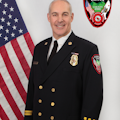
Bob Atlas
Bob Atlas is a Contra Costa County, CA, Fire Protection District (Con Fire) battalion chief, with responsibility for eight stations and crews. He entered the fire service as a community fire aide for the Milpitas, CA, Fire Department in 1996 followed by an internship with the South Santa Clara County Fire Protection District and Cal Fire in 1997. Atlas was employed as an EMT for American Medical Response before he was hired as a full-time professional firefighter with Con Fire in 1999. He was promoted to fire engineer in 2002, captain in 2005 and shift battalion chief in 2011. He is a California State Fire Marshal-certified chief fire officer and fire instructor and is a former member of the FEMA Urban Search and Rescue—California Task Force 4 and of Con Fire’s Technical Rescue Program. Atlas is a Red Carded Line Safety Officer and serves as a Certified Oral Board Rater. He is responsible for Con Fire's Engine Operations committee and CISM/Peer Support program. Atlas holds a bachelor’s degree in engineering from the University of Massachusetts and an associate degree in fire science from Mission College.
